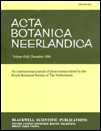Impact of pollination and resource limitation on seed production in a border population of Spiranthes spiralis (Orchidaceae)
Summary
Experiments on pollination were carried out in a border population of the terrestrial orchid Spiranthes spiralis (L.) Chevall. in the southern part of The Netherlands, one of the two remaining sites in the country. Experiments revealed that S. spiralis is a non-autogamous species. Visiting insects, mainly bumblebees, are needed for seed production, either by geitonogamy or cross-pollination. Insect-pollinated plants had 35% fruit set compared to 75% for flowers geitonogamously pollinated by hand. Removal of flowers of other species surrounding clumped flowering stalks of S. spiralis increased fruit set, indicating interspecific competition for pollinators. Fruit set was independent of the number of flowers per inflorescence. Since the number of seeds per fruit increased with the number of fruits per inflorescence, available resources do not limit the seed production. This is probably a result of the phenology of this species. Insect pollination does not appear to be a bottle-neck in the sustainability of this border population of the rare and endangered S. spiralis. Appropriate vegetation management of the site is probably essential if the population is to persist.




